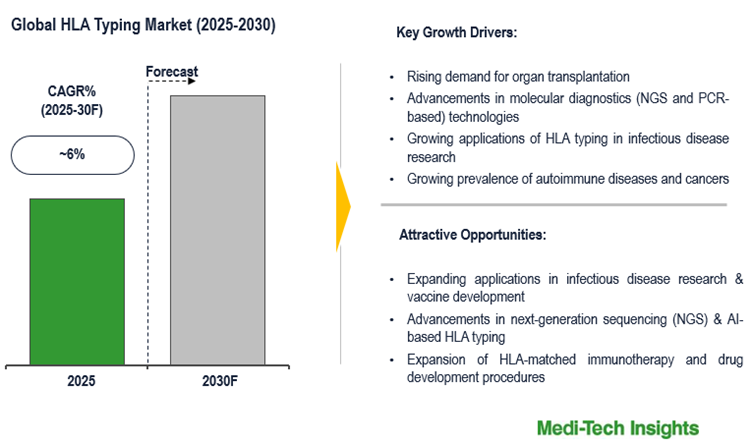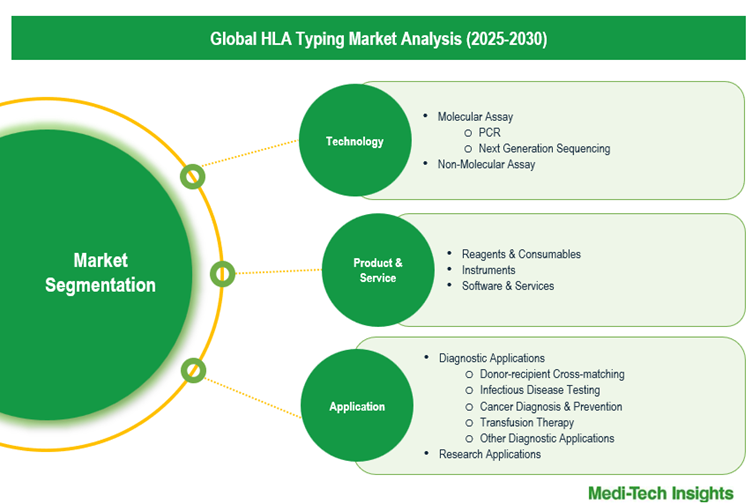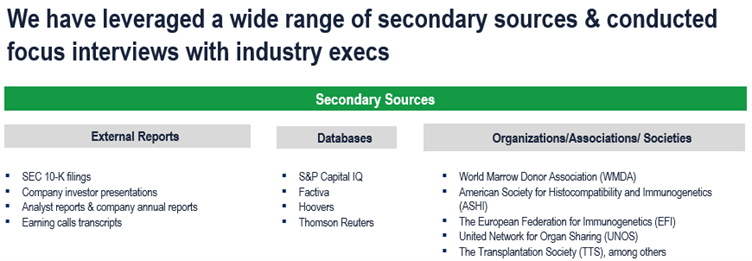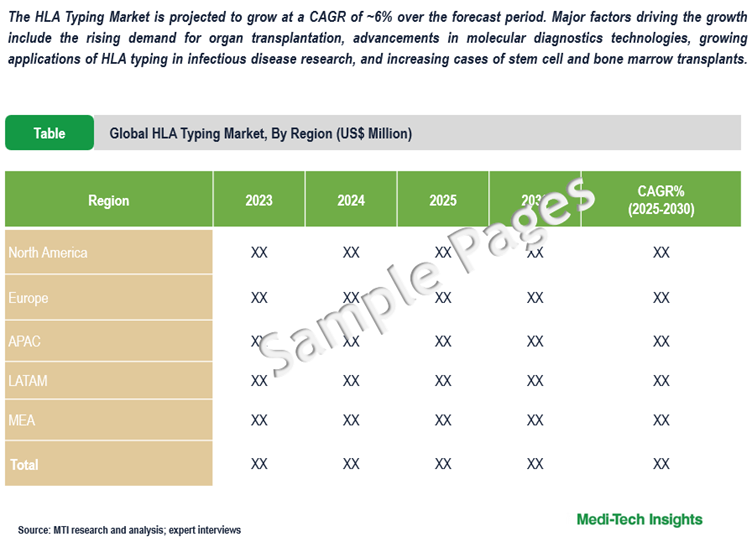
Global HLA Typing Market Size & Trends Report Segmented by Technology (Molecular, Non-Molecular), Product & Service (Instruments, Reagents & Consumables, Software & Services), Application (Diagnostic, Research), End User & Regional Forecast to 2030
The HLA typing market is projected to grow at a CAGR of ~6% over the forecast period. Major factors driving the growth include the rising demand for organ transplantation, advancements in molecular diagnostic (NGS and PCR-based) technologies, growing applications of HLA typing in infectious disease research, increasing cases of stem cell and bone marrow transplants, growing prevalence of autoimmune diseases and cancers, and increasing awareness and enhanced organ donation rates globally. To learn more about the research report, download a sample report.
Report Overview
Human leukocyte antigen (HLA) testing, also known as HLA typing or tissue typing, is a genetic test that detects antigens on the surface of cells and tissues. Its primary purpose is to ensure compatibility between organ and tissue transplant recipients and potential donors. Additionally, HLA testing helps screen transplant recipients for antibodies that could trigger an immune response against the donated organ or tissue, increasing the risk of transplant rejection. The number of detected antibodies influences the likelihood of transplant success. Different types of transplants require varying degrees of donor-recipient matching, which determines the specific HLA tests and genes analyzed.

To learn more about the research report, download a sample report.
Advancements in molecular diagnostics technologies increase HLA typing adoption
Since the advent of polymerase chain reaction (PCR), DNA-based methods have become the dominant approach in HLA typing laboratories, offering high precision, reproducibility, sensitivity, and resolution. Key DNA-based techniques include PCR-sequence-specific primers (SSP), PCR-sequence-specific oligonucleotide (SSO), real-time PCR, sequencing-based typing (SBT), and next-generation sequencing (NGS).
Among these, NGS also known as high-throughput sequencing is increasingly emerging as the preferred HLA typing method due to its accuracy, high throughput, and speed. A major advantage of NGS is its ability to resolve ambiguities at a cost comparable to SBT, eliminating the need for additional screenings. The NGS process includes DNA library preparation, targeted gene amplification (via emulsion or solid-phase PCR), sequencing-based typing, and sequence alignment against databases such as the international ImMunoGeneTics project/human leukocyte antigen (IMGT/HLA) database. Additionally, advances in sequencing technologies and AI integration have further enhanced NGS accuracy, efficiency, automation, and portability. As diagnostics continue to evolve, the integration of qPCR and NGS is becoming essential to meet the rising demand for precision and personalized medicine, especially in oncology, where timely genetic insights can dramatically influence treatment choices.

To learn more about the research report, download a sample report.
Rising demand for organ transplantation drives market growth
The World Health Organization (WHO), the Global Observatory on Donation and Transplantation (GODT), and the Organización Nacional de Trasplantes (ONT) report a significant rise in global organ donation and transplantation activities. According to the 2023 International Report on Organ Donation and Transplantation, solid organ transplants increased by 9.5% in 2023 compared to 2022, reaching a total of 172,397 transplants worldwide. The increasing prevalence of end-stage organ failure, including kidney, liver, heart, and lung diseases, has significantly heightened the demand for organ transplants. Chronic conditions such as diabetes, hypertension, and cardiovascular diseases are leading contributors to kidney failure, driving the need for renal transplants. Likewise, liver transplants remain in high demand due to hepatitis, cirrhosis, and alcohol-related liver diseases.
As the number of patients in need of organ and tissue transplants continues to grow, precise donor-recipient matching has become increasingly essential for successful transplantation. HLA typing plays a critical role in determining compatibility, reducing rejection risks, and improving overall transplant success rates. By identifying the most suitable match, accurate HLA typing significantly lowers the likelihood of transplant rejection, especially in bone marrow, kidney, liver, and heart transplants. As demand for organ transplants surges, the need for high-precision HLA typing also rises, ensuring better patient outcomes and long-term survival.
Competitive Landscape Analysis
The global HLA typing market is marked by the presence of established and emerging market players such as Thermo Fisher Scientific Inc.; Bio-Rad Laboratories Inc.; Qiagen N.V.; Omixon Inc.; GenDx; Illumina Inc.; TBG Diagnostics Limited; Dickinson and Company; Takara Bio Inc.; F. Hoffman-La Roche Limited; Pacific Biosciences; Immucor, Inc.; and CareDx, Inc.; among others. Some of the key strategies adopted by market players include new product development, strategic partnerships and collaborations, and investments.
Report Scope
|
In\Report Scope |
Details |
|
Base Year Considered |
2024 |
|
Historical Data |
2023 - 2024 |
|
Forecast Period |
2025 - 2030 |
|
Growth Rate |
~6% |
|
Market Drivers |
|
|
Attractive Opportunities |
|
|
Segment Scope |
Technology, Product & Service, Application, and End User |
|
Regional Scope |
|
|
Key Companies Mapped |
Thermo Fisher Scientific Inc.; Bio-Rad Laboratories Inc.; Qiagen N.V.; Omixon Inc.; GenDx; Illumina Inc.; TBG Diagnostics Limited; Dickinson and Company; Takara Bio Inc.; F. Hoffman-La Roche Limited; Pacific Biosciences; Immucor, Inc.; and CareDx, Inc. |
|
Report Highlights |
Market Size & Forecast, Growth Drivers & Restraints, Trends, Competitive Analysis |
Market Segmentation
This report by Medi-Tech Insights provides the size of the global HLA typing market at the regional and country levels from 2023 to 2030. The report further segments the market based on technology, product and service, application, and end user.
- Market Size & Forecast (2023-2030), By Technology, USD Million
- Molecular Assay
- PCR
- Next Generation Sequencing
- Non-Molecular Assay
- Molecular Assay
- Market Size & Forecast (2023-2030), By Product & Service, USD Million
- Reagents & Consumables
- Instruments
- Software & Services
- Market Size & Forecast (2023-2030), By Application, USD Million
- Diagnostic Applications
- Donor-Recipient Cross-Matching
- Infectious Disease Testing
- Cancer Diagnosis & Prevention
- Transfusion Therapy
- Other Diagnostic Applications
- Research Applications
- Diagnostic Applications
- Market Size & Forecast (2023-2030), By End User, USD Million
- Commercial Service Providers
- Hospitals & Surgical Centers
- Research Laboratories & Academic Institutes
- Market Size & Forecast (2023-2030), By Region, USD Million
- North America
- US
- Canada
- Europe
- UK
- Germany
- France
- Italy
- Spain
- Rest of Europe
- Asia Pacific
- China
- India
- Japan
- Rest of Asia Pacific
- Latin America
- Middle East & Africa
- North America
Key Strategic Questions Addressed
- What is the market size & forecast of the HLA typing market?
- What are the historical, present, and forecasted market shares and growth rates of various segments and sub-segments of the HLA typing market?
- What are the key trends defining the market?
- What are the major factors impacting the market?
- What are the opportunities prevailing in the market?
- Which region has the highest share in the global market? Which region is expected to witness the highest growth rate in the next 5 years?
- Who are the major players operating in the market?
- What are the key strategies adopted by players?
- Introduction
- Introduction
- Market Scope
- Market Definition
- Segments Covered
- Regional Segmentation
- Research Timeframe
- Currency Considered
- Study Limitations
- Stakeholders
- List of Abbreviations
- Key Conferences and Events (2025-2026)
- Research Methodology
- Secondary Research
- Primary Research
- Market Estimation
- Bottom-Up Approach
- Top-Down Approach
- Market Forecasting
- Executive Summary
- HLA Typing Market Snapshot (2025-2030)
- Segment Overview
- Regional Snapshot
- Competitive Insights
- Market Overview
- Market Dynamics
- Drivers
- Rising demand for organ transplantation
- Advancements in molecular diagnostics (NGS- and PCR-based) technologies
- Growing applications of HLA typing in infectious disease research
- Increasing cases of stem cell and bone marrow transplants
- Growing prevalence of autoimmune diseases and cancers
- Restraints
- High cost of HLA typing technologies
- Limited availability of organ donors
- Regulatory and ethical concerns in genetic testing
- Opportunities
- Expanding applications in infectious disease research & vaccine development
- Advancements in NGS & AI-based HLA typing
- Expansion of HLA-matched immunotherapy and drug development procedures
- Drivers
- Market Dynamics
-
- Key Market Trends
- Adoption of AI & machine learning in HLA data analysis
- Expansion of direct-to-consumer HLA testing services
- Development of cost-effective point-of-care HLA typing solutions
- Unmet Market Needs
- Industry Speaks
- Key Market Trends
- Global HLA Typing Market Size & Forecast (2023-2030), By Technology, USD Million
- Introduction
- Molecular Assay
- PCR
- Next Generation Sequencing
- Non-Molecular Assay
- Global HLA Typing Market Size & Forecast (2023-2030), By Product & Service, USD Million
- Introduction
- Reagents & Consumables
- Instruments
- Software & Services
- Global HLA Typing Market Size & Forecast (2023-2030), By Application, USD Million
- Introduction
- Diagnostic Applications
- Donor-Recipient Cross-Matching
- Infectious Disease Testing
- Cancer Diagnosis & Prevention
- Transfusion Therapy
- Other Diagnostic Applications
- Research Applications
- Global HLA Typing Market Size & Forecast (2023-2030), By End User, USD Million
- Introduction
- Commercial Service Providers
- Hospitals & Surgical Centers
- Research Laboratories & Academic Institutes
- Global HLA Typing Market Size & Forecast (2023-2030), By Region, USD Million
- Introduction
- North America HLA Typing Market Size & Forecast (2023-2030), By Country, USD Million
- US
- Market Size & Forecast, By Technology (USD Million)
- Market Size & Forecast, By Product & Service (USD Million)
- Market Size & Forecast, By Application (USD Million)
- Market Size & Forecast, By End User (USD Million)
- Canada
- Market Size & Forecast, By Technology (USD Million)
- Market Size & Forecast, By Product & Service (USD Million)
- Market Size & Forecast, By Application (USD Million)
- Market Size & Forecast, By End User (USD Million)
- US
- Europe HLA Typing Market Size & Forecast (2023-2030), By Country, USD Million
- UK
- Market Size & Forecast, By Technology (USD Million)
- Market Size & Forecast, By Product & Service (USD Million)
- Market Size & Forecast, By Application (USD Million)
- Market Size & Forecast, By End User (USD Million)
- Germany
- Market Size & Forecast, By Technology (USD Million)
- Market Size & Forecast, By Product & Service (USD Million)
- Market Size & Forecast, By Application (USD Million)
- Market Size & Forecast, By End User (USD Million)
- France
- Market Size & Forecast, By Technology (USD Million)
- Market Size & Forecast, By Product & Service (USD Million)
- Market Size & Forecast, By Application (USD Million)
- Market Size & Forecast, By End User (USD Million)
- Italy
- Market Size & Forecast, By Technology (USD Million)
- Market Size & Forecast, By Product & Service (USD Million)
- Market Size & Forecast, By Application (USD Million)
- Market Size & Forecast, By End User (USD Million)
- Spain
- Market Size & Forecast, By Technology (USD Million)
- Market Size & Forecast, By Product & Service (USD Million)
- Market Size & Forecast, By Application (USD Million)
- Market Size & Forecast, By End User (USD Million)
- Rest of Europe
- Market Size & Forecast, By Technology (USD Million)
- Market Size & Forecast, By Product & Service (USD Million)
- Market Size & Forecast, By Application (USD Million)
- Market Size & Forecast, By End User (USD Million)
- UK
- Asia Pacific (APAC) HLA Typing Market Size & Forecast (2023-2030), By Country, USD Million
- China
- Market Size & Forecast, By Technology (USD Million)
- Market Size & Forecast, By Product & Service (USD Million)
- Market Size & Forecast, By Application (USD Million)
- Market Size & Forecast, By End User (USD Million)
- Japan
- Market Size & Forecast, By Technology (USD Million)
- Market Size & Forecast, By Product & Service (USD Million)
- Market Size & Forecast, By Application (USD Million)
- Market Size & Forecast, By End User (USD Million)
- India
- Market Size & Forecast, By Technology (USD Million)
- Market Size & Forecast, By Product & Service (USD Million)
- Market Size & Forecast, By Application (USD Million)
- Market Size & Forecast, By End User (USD Million)
- Rest of Asia Pacific
- Market Size & Forecast, By Technology (USD Million)
- Market Size & Forecast, By Product & Service (USD Million)
- Market Size & Forecast, By Application (USD Million)
- Market Size & Forecast, By End User (USD Million)
- China
- Latin America (LATAM) HLA Typing Market Size & Forecast (2023-2030), USD Million
- Market Size & Forecast, By Technology (USD Million)
- Market Size & Forecast, By Product & Service (USD Million)
- Market Size & Forecast, By Application (USD Million)
- Market Size & Forecast, By End User (USD Million)
- Middle East & Africa (MEA) HLA Typing Market Size & Forecast (2023-2030), USD Million
- Market Size & Forecast, By Technology (USD Million)
- Market Size & Forecast, By Product & Service (USD Million)
- Market Size & Forecast, By Application (USD Million)
- Market Size & Forecast, By End User (USD Million)
- Competitive Landscape
- Key Players and their Competitive Positioning
- Key Player Comparison
- Segment-wise Player Mapping
- Market Share Analysis (2024)
- Company Categorization Matrix
- Dominants/Leaders
- New Entrants
- Emerging Players
- Innovative Players
- Key Strategies Assessment, By Player (2022-2025)
- New Product Launches
- Partnerships, Agreements, & Collaborations
- Mergers & Acquisitions
- Geographic Expansion
- Key Players and their Competitive Positioning
- Company Profiles* (Business Overview, Financial Performance**, Products Offered, Recent Developments)
- Thermo Fisher Scientific Inc.
- Bio-Rad Laboratories Inc.
- Qiagen N.V.
- Omixon Inc.
- GenDx
- Illumina Inc.
- TBG Diagnostics Limited
- Dickinson and Company
- Takara Bio Inc.
- Hoffman-La Roche Limited
- Other Prominent Players
Note: *Indicative list
**For listed companies
The study has been compiled based on extensive primary and secondary research.
Secondary Research (Indicative List)

Primary Research
To validate research findings (market size & forecasts, market segmentation, market dynamics, competitive landscape, key industry trends, etc.), extensive primary interviews were conducted with both supply and demand-side stakeholders.
Supply Side Stakeholders:
- Senior Management Level: CEOs, Presidents, Vice-Presidents, Directors, Chief Technology Officers, Chief Commercial Officers
- Mid-Management Level: Product Managers, Sales Managers, Brand Managers, R&D Managers, Business Development Managers, Consultants
Demand Side Stakeholders:
- Stakeholders from Commercial Service Providers, Hospitals & Surgical Centers, Research Laboratories Academic Institutes, and Others
Breakdown of Primary Interviews

Market Size Estimation
Both ‘Top-Down & Bottom-Up Approaches’ were used to derive market size estimates and forecasts.
Data Triangulation
Research findings derived through secondary sources & internal analysis were validated with Primary Interviews, the Internal Knowledge Repository, and the Company’s Sales Data.



